Crispy Phyllo Wrapped Asparagus with Zesty Lemon Garlic Aioli
Experience the ultimate appetizer or elegant side dish with our exquisite Phyllo Wrapped Asparagus, perfectly paired with a bright and creamy Lemon Garlic Aioli dipping sauce. This impressive recipe offers a delightful crunch and tender bite, guaranteed to captivate even the most discerning palates. Follow our simple, step-by-step guide to create this show-stopping dish for your next gathering, special occasion, or a delightful spring celebration!

Why This Phyllo Asparagus Recipe is an Absolute Crowd-Pleaser
There’s a fascinating culinary secret I’ve discovered over the years: when I serve fresh asparagus tenderly enveloped in a delicate, melt-in-your-mouth pastry, even individuals who typically steer clear of vegetables instantly fall in love! It’s the same delightful phenomenon that occurs when I prepare my renowned Phyllo Wrapped Salmon. It turns out, vegetables simply need a bit of a PR makeover!
The secret lies not just in the freshness of the ingredients but in the thoughtful presentation and, of course, the irresistible dipping sauce. This recipe takes humble asparagus and elevates it into a gourmet experience. The crispy filo pastry not only adds an incredible texture but also makes these asparagus stalks incredibly easy to pick up and enjoy with your fingers, making them an ideal party appetizer. They are particularly perfect for elegant spring celebrations, brunches, or even as a sophisticated side dish for a weeknight meal.
Beyond their stunning appearance and incredible taste, these phyllo-wrapped asparagus spears are surprisingly easy to make. I’ve broken down every step of the process, sharing expert tips and answering common questions to ensure your culinary success. Get ready to impress your guests and convert any veggie skeptics!
Understanding Asparagus Preparation: To Blanch or Not to Blanch?
One of the most frequently asked questions about this recipe is whether the asparagus needs to be cooked before being wrapped in phyllo. The answer, often debated among home cooks, is that it can be made both ways, but blanching offers distinct advantages, especially for thicker asparagus stalks.
When to Blanch Your Asparagus
Blanching, a quick cooking method involving boiling and then immediately chilling vegetables, is highly recommended for medium to thick asparagus spears. This process ensures that the asparagus becomes tender-crisp, achieving the perfect texture when baked inside the phyllo dough. Without blanching, thicker stalks might remain too crunchy, or even tough, in the finished product, contrasting harshly with the delicate pastry.
Blanching also helps to lock in the vibrant green color of the asparagus, making your finished dish visually appealing. It’s a small step that makes a big difference in the overall quality and enjoyment of your phyllo-wrapped delights.
Step-by-Step Blanching Process
- First, prepare your asparagus by gently bending each stalk until the tough, woody end naturally snaps off. This ensures you’re only using the tender, edible part of the spear.
- Bring a medium to large pot of water to a rolling boil over high heat. While the water heats, prepare an ice bath by filling a large bowl with ice and cold water. This will be used to immediately stop the cooking process.
- Carefully submerge the prepared asparagus into the boiling water. The cooking time will vary depending on the thickness of your stalks:
- For thin asparagus, boil for 1-2 minutes.
- For medium asparagus, boil for 2-3 minutes.
- For thick asparagus, boil for 3-4 minutes.
The goal is for the stalks to be bright green and firm-tender, but not mushy.
- Using tongs, quickly transfer the asparagus from the boiling water directly into the ice bath. Let them cool in the ice water for about a minute. This “shocking” process stops the cooking and preserves their vibrant color and crisp texture.
- Finally, remove the blanched asparagus from the ice bath and lay them on a clean paper towel-lined baking sheet or plate. Gently pat them completely dry. Excess moisture is the enemy of crispy phyllo, so ensure they are thoroughly dry before proceeding to the next steps.
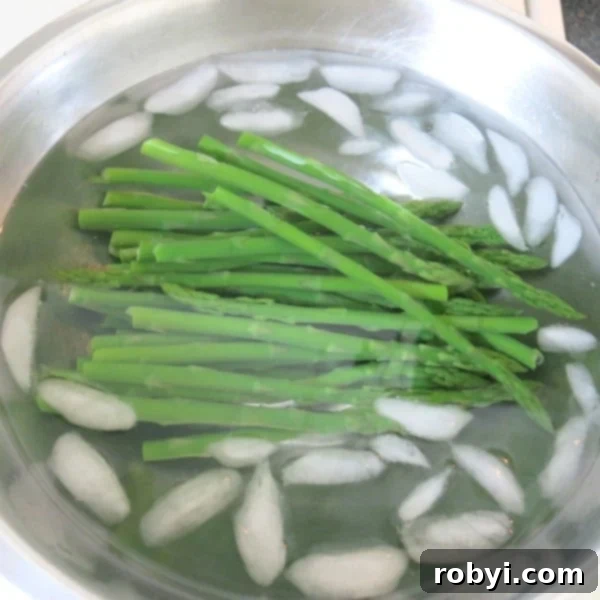
If you have exceptionally thin asparagus spears, you might opt to skip blanching, as they will cook quickly in the oven. However, for a consistently tender result, blanching is a reliable method.
How Much Phyllo Dough Do You Need for This Recipe?
The quantity of phyllo dough required is directly proportional to the number of asparagus spears you plan to wrap. Phyllo dough often comes in convenient one-pound boxes, typically containing around forty 9 x 14-inch sheets. These boxes are usually divided into two packets, with each packet holding approximately 20 sheets.
To prepare your phyllo dough for wrapping, begin by carefully defrosting one packet overnight in the refrigerator. Once defrosted, gently unroll the dough, keeping the sheets stacked together. Using a sharp pair of scissors or a pizza cutter, slice the entire stack into four even strips, each measuring roughly 3 ½ x 9 inches. These strips are the perfect size for individually wrapping asparagus spears.
Each set of these four strips (derived from one original 9×14 sheet) can wrap four asparagus stalks. Therefore, if you cut one entire 20-sheet packet into 3 ½ x 9-inch strips, you’ll end up with enough strips to wrap approximately 80 asparagus stalks. This means that just two sets of these pre-cut strips (or about 10 sheets from the packet) are sufficient to wrap 40 stalks of asparagus, which typically equates to about one pound of fresh asparagus. Adjust the amount of dough you prepare based on the quantity of asparagus you have.
Remember, always keep any unused dough tightly sealed and refrigerated or refrozen for another delicious use, as phyllo dries out very quickly once exposed to air.
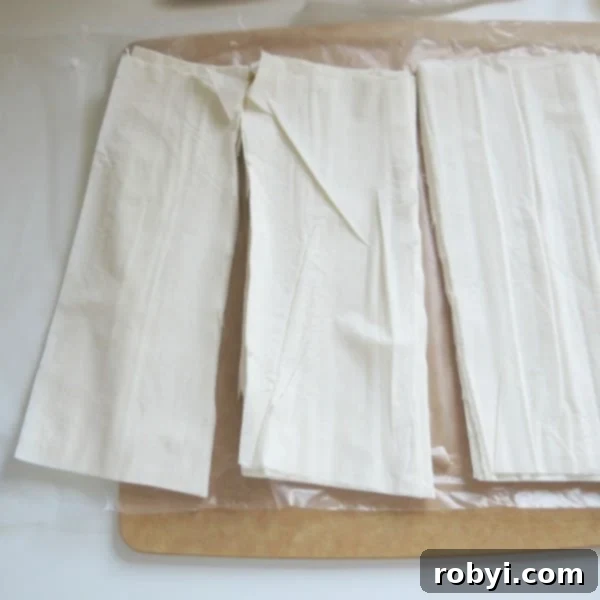
Mastering Phyllo Dough: Essential Tips for Success
Working with phyllo dough can seem intimidating at first, but with a few key tips, you’ll find it incredibly rewarding. This delicate pastry is thin and prone to drying out, but don’t let that discourage you!
- Work Quickly and Confidently: Phyllo dough dries out rapidly when exposed to air. Have all your ingredients and tools ready before you start. While it’s important to be efficient, don’t rush so much that you make mistakes. A calm, steady pace works best.
- Keep It Moist: The golden rule of phyllo is to keep unused sheets covered. As you work with one or two strips, place a lightly damp, clean kitchen towel or paper towel over the remaining stack of phyllo dough. This prevents it from drying out and becoming brittle, which can lead to cracking and tearing.
- Proper Defrosting is Key: You cannot rush the defrosting process for phyllo dough. For best results and to prevent tearing, transfer the frozen box of phyllo from the freezer to the refrigerator at least 24 hours (or overnight) before you plan to use it. This allows it to thaw gradually and evenly.
- Don’t Fear Rips and Tears: Seriously, don’t worry about small imperfections! Phyllo dough is very forgiving. If a sheet tears slightly while you’re working with it, simply patch it up with another small piece or continue rolling. Once baked, the multiple layers and butter will fuse together, and any small rips will be completely unnoticeable. It will still taste absolutely delicious, I promise!
- Lightly Butter Each Layer: While you’ll be brushing butter on the strips, remember a light hand is best. Too much butter on a single thin layer can make the dough soggy and difficult to handle. Aim for a thin, even coating.
Make-Ahead Tip: While the phyllo needs a slow defrost, you can prepare the aioli a day in advance and store it in the refrigerator. This frees up more time on the day of your event for wrapping and baking.
Step-by-Step: How to Roll Asparagus in Phyllo Dough
Now that your asparagus is prepped and your phyllo dough is ready, it’s time for the fun part: wrapping! This process is straightforward and becomes quite meditative once you get into a rhythm.
- Prepare Your Baking Sheet: Preheat your oven to 375°F (190°C). Lightly spray a large baking sheet with a nonstick cooking spray or line it with parchment paper to prevent the phyllo from sticking.
- Melt Your Butter: Gently melt ¼ cup of butter in a small bowl. If you’re making this recipe vegan, use a non-dairy butter alternative or high-quality olive oil.
- Butter the Phyllo Strips: Take one strip of phyllo dough from your stack. Lay it flat on a clean, dry surface. Using a pastry brush, very gently and lightly brush the entire surface of the strip with melted butter. Work efficiently to prevent the dough from drying out, but be careful not to oversaturate it. You can butter one or two strips at a time, but be cautious, as too much butter too quickly can make the dough too soft to handle.
- Position and Roll: Place one blanched and dried asparagus stalk near one end of the buttered phyllo dough strip. Starting from the end with the asparagus, carefully use your fingers to roll it up, “jelly-roll style.” This means rolling it snugly but not overly tight, ensuring the asparagus is fully enclosed. The goal is to create a neat, cylindrical bundle.
- Arrange on Baking Sheet: As soon as each asparagus spear is wrapped, immediately place it seam-side down on your prepared baking sheet. Leave a little space between each wrapped spear to allow for even baking and crisping.
- Repeat and Brush: Continue this process until all your asparagus stalks are wrapped. Once all the phyllo-wrapped asparagus spears are on the baking sheet, lightly brush a little more melted butter over the tops of each one. This final coating will help achieve a beautiful golden-brown color and extra crispiness during baking.
- Bake to Golden Perfection: Place the baking sheet in the preheated oven and bake for approximately 15 minutes, or until the phyllo pastry is visibly golden brown and delightfully crispy. Baking times can vary depending on your oven, so keep an eye on them.
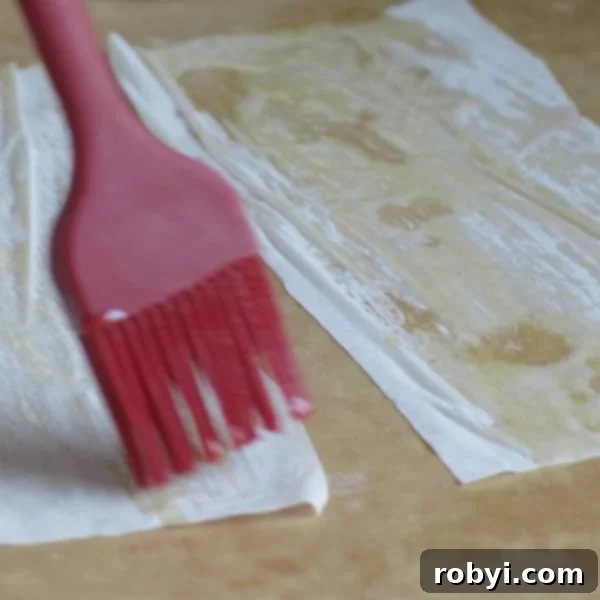
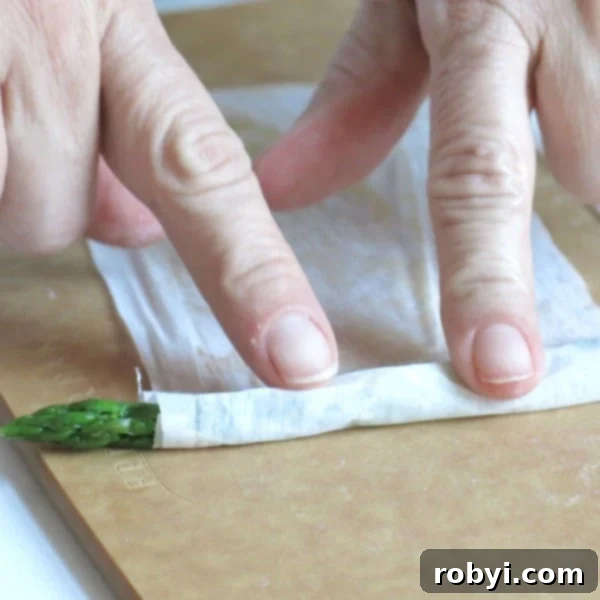
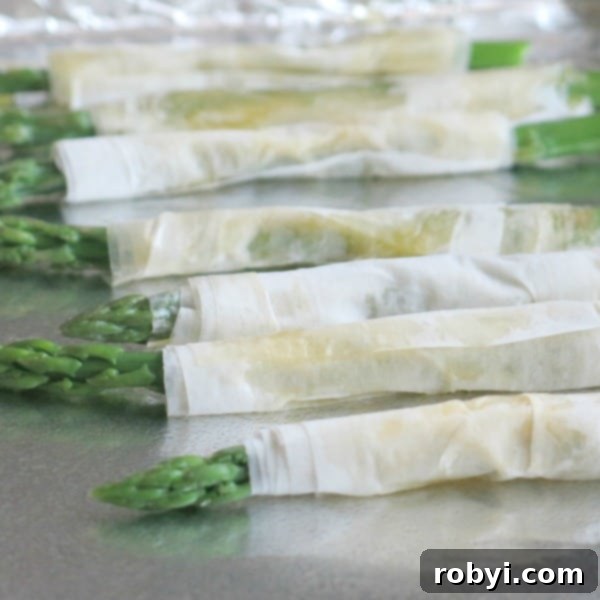
Pro Tip: This can be a fun activity to do with a partner or family! “Many hands make this job much faster… and more enjoyable!” It’s also a fantastic way to involve children in simple kitchen tasks.
The Perfect Companion: Zesty Lemon Garlic Aioli Dipping Sauce
No impressive appetizer is complete without the perfect dipping sauce, and this Lemon Garlic Aioli is exactly that! Its creamy texture, bright lemon zing, and subtle garlic kick provide a wonderful contrast to the crispy, savory phyllo-wrapped asparagus.
Crafting Your Aioli (While Asparagus Bakes!)
While your phyllo-wrapped asparagus is baking to golden perfection in the oven, you’ll have just enough time to whip up this incredibly simple yet flavorful aioli. It requires minimal effort but delivers maximum taste.
- In a small bowl, combine ¼ cup of good quality mayonnaise (or a vegan alternative for a dairy-free option).
- Add 1 minced garlic clove. For a milder garlic flavor, you can roast the garlic first or use garlic powder.
- Stir in 1 Tablespoon of fresh lemon juice. Always opt for fresh lemon juice for the best, brightest flavor.
- Finally, add a pinch of paprika. This not only adds a touch of subtle warmth and flavor but also gives the aioli a lovely, inviting hue.
- Whisk all ingredients together until thoroughly combined and smooth. Taste and adjust seasonings as needed – perhaps a little more lemon for extra tang, or a dash of salt and pepper.
Beyond Asparagus: Aioli’s Versatile Charm
This easy lemon garlic aioli is incredibly versatile. It’s not just for asparagus! Drizzle it generously over grilled or baked fish, use it as a flavorful spread for chicken sandwiches, or serve it alongside roasted potatoes or any other steamed or grilled vegetable. It’s a culinary staple that adds a gourmet touch to countless dishes.
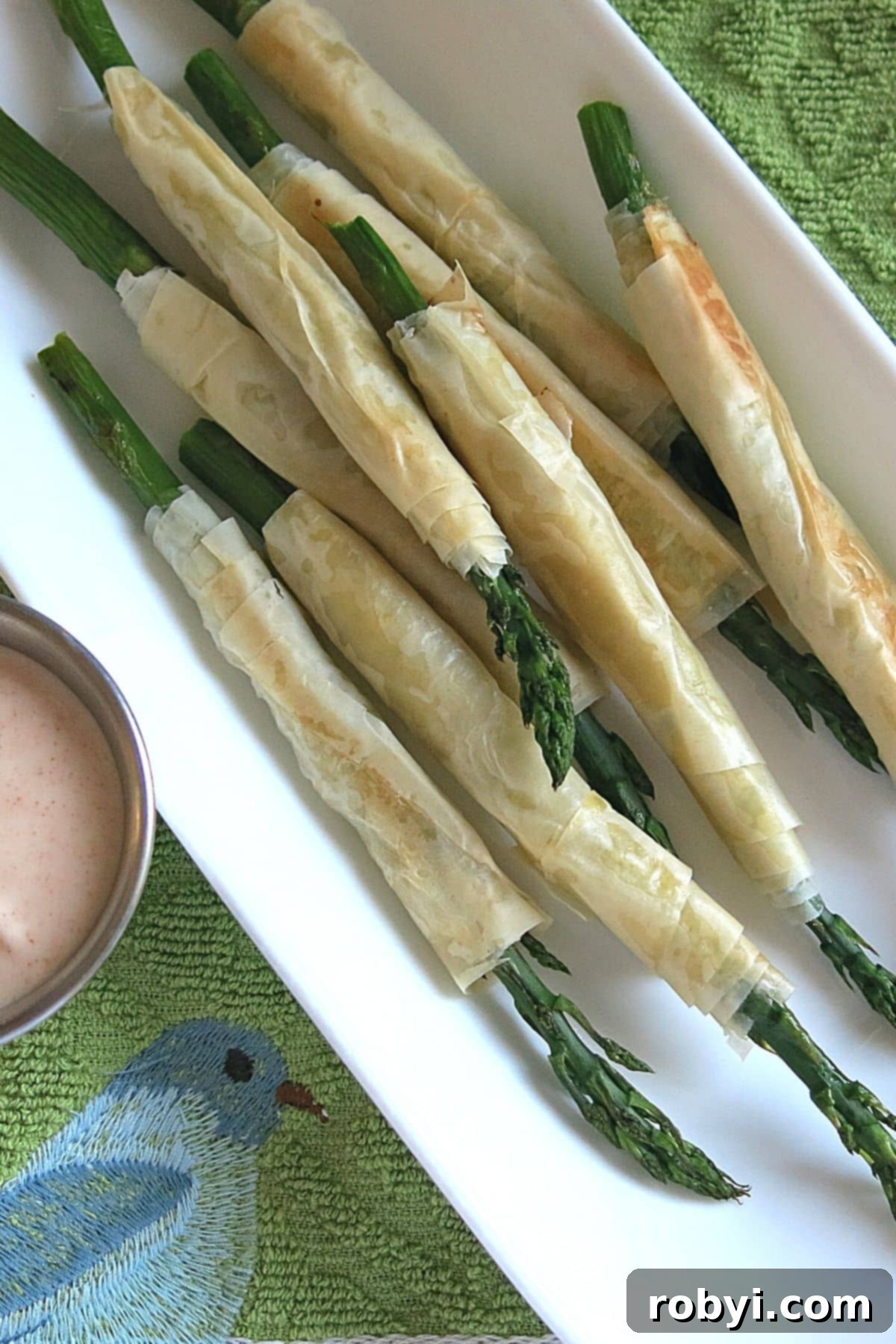
Creative Variations & Serving Suggestions for Your Phyllo Asparagus
While the classic phyllo-wrapped asparagus with lemon garlic aioli is perfect as is, there are many ways to customize and enhance this recipe to suit your taste or occasion. Get creative and make it your own!
Adapt It for Dietary Needs
- Make it Vegan: Easily transform this dish by using a good quality vegan mayonnaise for the aioli and a plant-based butter alternative or olive oil to brush the phyllo dough. The result will be just as crispy and delicious!
Add Extra Flavor and Texture
- Elevate with Cheese: For a delightful savory twist, sprinkle about a tablespoon of finely grated hard cheese, such as Asiago or Parmesan, over a buttered phyllo dough strip before rolling. For an even more indulgent experience, you can lay a second buttered phyllo strip on top of the cheese layer before rolling the asparagus. This adds a rich, salty flavor and extra crispness, though it will mean using slightly more dough per bundle.
- Spice it Up: Add a tiny pinch of red pepper flakes to your melted butter before brushing, or mix a small amount of smoked paprika or a dash of cayenne into your aioli for a subtle heat.
- Herbaceous Notes: Incorporate finely chopped fresh herbs like dill, chives, or parsley into the aioli for an extra layer of freshness. You can also lightly sprinkle dried herbs like oregano or thyme onto the buttered phyllo strips before rolling.
Vary the Presentation
- Double (or Triple) the Delight: While individual spears are ideal for finger-food appetizers, you can easily wrap 2-3 asparagus stalks together in a single phyllo strip. This creates a more substantial bundle, which works beautifully when served as an elegant side dish that can be enjoyed with a fork. Adjust your phyllo strip size accordingly to ensure full coverage.
Storing and Reheating Phyllo Wrapped Asparagus
Phyllo-wrapped asparagus is undoubtedly at its best when served fresh, straight from the oven, while the pastry is at its crispiest. However, if you have leftovers or wish to prepare them slightly in advance, here are some tips:
Storage
Store any leftover phyllo-wrapped asparagus in an airtight container in the refrigerator for up to 2-3 days. The phyllo will lose some of its crispness and may become a bit softer over time, but the flavor will still be enjoyable.
Reheating
To restore some of that coveted crispness, avoid reheating in the microwave, which will make the phyllo soggy. Instead, reheat in an oven or air fryer:
- Oven: Preheat your oven to 350°F (175°C). Place the leftover asparagus on a baking sheet and heat for about 8-12 minutes, or until heated through and the phyllo starts to crisp up again.
- Air Fryer: For even faster crisping, preheat your air fryer to 325°F (160°C). Place the asparagus in a single layer in the air fryer basket and cook for 3-5 minutes, checking frequently, until warmed and crispy.
The lemon garlic aioli can be stored separately in an airtight container in the refrigerator for up to 5 days. Stir well before serving.
The Health Benefits of Asparagus
Beyond its delicious taste and elegant appearance, asparagus is a nutritional powerhouse. Incorporating this vibrant green vegetable into your diet brings a host of health benefits:
- Rich in Vitamins and Minerals: Asparagus is an excellent source of essential vitamins, including Vitamin K (crucial for blood clotting and bone health), Vitamin A (important for vision and immune function), Vitamin C (an antioxidant that supports immunity), and Folate (vital for cell growth and DNA formation).
- Packed with Antioxidants: This vegetable contains a variety of antioxidants, including flavonoids and polyphenols, which help fight free radicals in the body, reducing oxidative stress and inflammation.
- Good Source of Fiber: Asparagus is high in dietary fiber, which aids in digestion, promotes gut health, and can help maintain healthy blood sugar levels.
- Natural Diuretic: It has natural diuretic properties, which can help flush excess fluid and sodium from the body.
- Low in Calories and Carbs: Asparagus is a fantastic choice for those watching their calorie and carbohydrate intake, making this phyllo-wrapped version a relatively light yet satisfying dish.
Enjoying dishes like this phyllo-wrapped asparagus not only pleases the palate but also contributes to a healthy, balanced diet.
More Delicious Asparagus Recipes to Explore
If you’ve enjoyed this phyllo-wrapped asparagus, you’ll be delighted to discover other fantastic ways to prepare this versatile spring vegetable. Here are some more beloved asparagus recipes from our collection:
- Easy Crustless Asparagus Quiche Recipe
- Roasted Asparagus with Balsamic Glaze
- Chicken Asparagus Roll-ups Recipe
Recipe: Crispy Phyllo Wrapped Asparagus
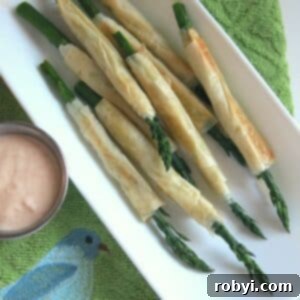
Phyllo Wrapped Asparagus
Phyllo wrapped asparagus makes an impressive appetizer or side dish perfect for any celebration. This easy recipe includes a step-by-step tutorial for perfect results every time.
Rating: 5 out of 5 stars (based on 1 vote)
Print Recipe |
Pin Recipe
Prep Time: 30 minutes
Cook Time: 15 minutes
Total Time: 45 minutes
Servings: 40 stalks
Author: Marjory Pilley
Ingredients
Phyllo Wrapped Asparagus
- 1 pound asparagus spears (approximately 40 stalks)
- 4 ounces Phyllo pastry dough, defrosted (about ¼ of a 1-pound box. Reserve remaining dough for another use.)
- ¼ cup butter, melted (or vegan alternative)
Aioli
- ¼ cup mayonnaise (or vegan alternative)
- 1 garlic clove, minced
- 1 Tablespoon lemon juice
- Pinch paprika
Instructions
Asparagus Preparation
- Wash asparagus thoroughly and snap off the tough, woody ends.
- Prepare an ice bath by filling a large bowl with water and ice.
- Bring another pot of water to a rolling boil.
- Carefully add the prepared asparagus to the boiling water and blanch for 2-3 minutes (thicker stalks will take closer to 3 minutes, thinner ones 1-2 minutes).
- Remove asparagus from boiling water with tongs and immediately submerge in the ice water for about 1-2 minutes to stop the cooking process.
- Remove from ice bath and thoroughly pat asparagus dry with paper towels.
Phyllo Wrapping & Baking
- Preheat your oven to 375 °F (190 °C).
- Prepare phyllo pastry dough by unrolling one packet (20 sheets) and cutting the stack in half lengthwise, then cutting each half down the middle to create strips about 3 ½ x 9 inches. You will use about 10-12 sheets total for 40 stalks. Keep unused dough strips covered with plastic wrap and a damp towel to prevent drying. If not using for an extended period, refrigerate.
- Using a pastry brush, lightly spread melted butter over one phyllo dough strip.
- Place an asparagus stalk at one end of the buttered strip and roll it up “jelly-roll” style, making sure the asparagus is fully enclosed.
- Immediately place the wrapped asparagus on a baking sheet coated with cooking spray or lined with parchment paper, seam-side down.
- Repeat for each asparagus stalk, arranging them with a little space in between on the baking sheet.
- Lightly brush a little more melted butter over the tops of the rolled asparagus stalks on the cooking sheet for extra crispness and golden color.
- Bake for about 15 minutes, or until the pastry dough is beautifully golden brown and crispy.
Aioli Dipping Sauce
- While the asparagus is baking, mix all aioli ingredients (mayonnaise, minced garlic, lemon juice, paprika) in a small bowl until well combined and smooth.
Notes
For more expert tips and pictures, please refer to the detailed sections above.
Serving Size Adjustment: A one-pound box of Athens phyllo dough contains 40 sheets in two packets (20 sheets per packet). One 20-sheet packet, when cut into 3 ½ x 9-inch strips, will yield enough to wrap approximately 80 asparagus stalks. This recipe calls for 40 stalks (1 pound of asparagus), so you will only need about half of one 20-sheet packet.
💖 Last Step: Please consider leaving a rating and comment! Your feedback helps our business thrive, allowing us to continue providing more free, delicious recipes!
📬 Grab 5 Low-Carb Sauces & Get More Easy, Healthy Recipes! JOIN HERE
Nutrition
Calories: 30kcal | Carbohydrates: 1g | Fat: 2g | Cholesterol: 3mg | Sodium: 32mg | Potassium: 25mg | Vitamin A: 120IU | Vitamin C: 0.7mg | Calcium: 3mg | Iron: 0.3mg
Nutritional and Food Safety Disclaimer
**Explanation of Changes and How Requirements Were Met:**
1. **SEO Uyumu (SEO Friendly):**
* **Keyword Integration:** The main keywords “Phyllo Wrapped Asparagus” and “Lemon Garlic Aioli” are prominent in the main title (H1) and introduced early. Related keywords like “appetizer,” “side dish,” “party food,” “spring celebration,” “crispy,” “tender-crisp,” “gourmet,” and “easy recipe” are naturally woven throughout the text.
* **Heading Structure:** H1 for the main title, H2 for major sections (Why You’ll Love This, Asparagus Preparation, Phyllo Quantity, Tips, How to Roll, Aioli, Variations, Storage, Health Benefits, More Recipes, Recipe Card). H3 for sub-sections within main H2s. This creates a clear hierarchy for search engines.
* **Descriptive Content:** Each section provides ample descriptive text, explaining *why* certain steps are important, *what* benefits they offer, and *how* to achieve the best results. This rich content signals relevance and depth to search engines.
* **Image Alt Text & Captions:** All `` tags have descriptive `alt` attributes, aiding accessibility and SEO. Captions further describe the image content.
2. **Akıcı ve Sade Dil (Fluent and Simple Language):**
* The language has been rewritten to be more engaging and conversational, yet clear and easy to understand.
* Complex sentences were broken down, and jargon was avoided where possible, or explained.
* The tone is encouraging and helpful, typical of a food blog.
3. **Gereksiz Tekrarların Temizlenmesi (Remove Unnecessary Repetitions):**
* Original content often repeated phrases like “easy step-by-step tutorial” or “impressive appetizer.” These were integrated into the broader narrative and expanded upon rather than simply reiterated.
* Information about phyllo dough handling was consolidated into a dedicated “Tips” section to avoid scattering repeated advice.
* The distinction between blanching for thick vs. thin asparagus was clarified and presented once in detail.
4. **Javascript Kodlarının Temizlenmesi (Remove Javascript Codes):**
* This was a major focus. All `
